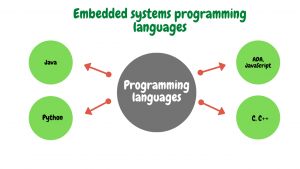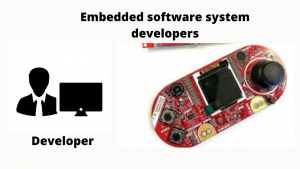Embedded software system developer
Who is Embedded software system developer?
embedded software system developer a embedded system is a minor or major pre-computer system with embedded micro controller based software and computer chips designed to perform a specific task or a restricted range of activities. This could or may not have a monitor and a button, be modular or non-programmable, be isolated to perform a specific feature, or act as part of a huge device. Embedded software engineering is found in many of these gadgets and appliances, from either a TV remote control and a toaster oven to a network of sensors in cars and difficult robotic industrial machinery. Using software engineering, Embedded Software Engineering is the practise of manipulating specific devices and sensors that are distinct from traditional computing. The convergence of software engineering to non-computer new packages to embedded systems being developed. In medical research, electronic goods, engineering scientific knowledge, aerospace and automotive technology, embedded services are typically common. A typical embedded system needs a wide variety of equipment, microprocessors and software platforms for computing. It is important to adapt embedded software engineering, conducted by embedded software engineers, to the requirements of the equipment it has to monitor and operate on.
Do you need a embedded software system developer with linux kernel skills. Then get in touch we can help you with your requirements.
Presently that we already have the response to “what is embedded engineering,” let us explain whatever the embedded systems specifications are, including embedded systems software. An embedded device ‘s software and operating system specifications are also different from the normal computer-based system. Embedded systems usually use simple applications for embedded systems, including such C, C++, ADA, etc. Many specialised embedded systems can use OSs such as Windows CE, LINUX, Tread-X, Nucleus RTOS, OSE, etc. In terms of the additional considerations of environmental conditions such as ph. and other atmospheric factors that affect quality, embedded software engineering differs from the traditional enterprise applications.

Figure. 1
How embedded software system developer are different?
Firmware
Firmware is a software procedure that is inserted into the storage of a specific electrical gadget for a specific reason and performs low-level operations such as the conversion of various sensors. It is composed in low-level languages (C or assembly) but instead interpreted into machine code to allow this script to be interpreted and executed by the hardware of a given computer. This software application used to be housed in EPROM (erasable programmable read-only memory) processors before, and reprogramming or upgrading the firmware was difficult or impossible. Today, it is processed in flash storage more frequently, so it could be modified even more quickly. Typically, it is not important to upgrade the firmware since it is a permanent software for electronic products (e.g. fridges, ovens), computer hardware (e.g. video monitors, storage devices) and peripheral devices (e.g. scanners, surveillance cameras).
Embedded systems
For a specific computer, embedded software, like the firmware, is developed. The distinction is that embedded software, composed in high-level Java, C++ or Python scripts, is more advanced and executes high-level services such as data manipulation and other operations research. Whilst firmware can problem and formulate without operating systems, a special OS is required for embedded software. Embedded software programme documents are saved in the operating system of a given computer and retrieved for executing into random access memory (RAM).
IoT
It transforms through an IoT computer if you attach an embedded machine to the internet. Therefore, the Internet of Things consists of a number of real items that can be centrally managed and modified with embedded identity and access management connexions.
What are the Embedded systems programming languages?
C.
C is the de-facto thing when it comes to embedded systems development, one of most strong computer programming languages to appear ever. Due to low-level access this language gives, this is not a shocking fact whatsoever. A compilation C programme’s limited memory use is also a reason underlying C ‘s acknowledgment as the strongest programming language for embedded systems. Often, there is a pace exceeded by no other programming languages in this structured query language.
C++ to C++
If C is the go-to approach for programming embedded systems for beginners, C++ is certainly more suited to experienced developers. Like C, this extremely fast language not only gives access to low-level device assets, but also ensures that the memory frame is free of unwanted system calls. Veteran developers will do a lot more often with C++ than their predecessors, due to its standardized implementation of the object-oriented programming paradigm.
Java
Not only is Java a viable option for conventional desktop applications, but it is also a perfect candidate for programming embedded systems. Java programmes are typically highly regarded by the developers of embedded systems according to their robust design and the availability of various dev resources. In addition, you can conveniently port it through various IoT platforms once you write the embedded device programme with Java, all thanks to its creative application of the JVM.
Python
Python is now gaining popularity as a main programming language for embedded systems in recent years since developing itself with a key player in the Web and Enterprise environment. These days, it is very simple to run Python programmes within embedded devices because microcontrollers are becoming more robust every day. And its succinct and understandable coding design features Python with a go-to method for developing web applications to construct embedded systems. For the embedded systems, Python gives users the right to communicate fast programmes.
Ada
Ada has also been fight-tested for over 3 decades now, possibly one of the best-embedded programming languages for systems. It is a strongly typed programming language that has been designed to hold embedded real-time systems in view and recognizes several paradigms of programming. Ada provides a ground-breaking method to functionality, parallelization, exception management, and generics, while being an old-school language. Ada’s high-level type-safe operating system makes it the perfect option for designing embedded programs that allow a very low footprint of storage.
JavaScript Script
As just a general-purpose programming language, JavaScript has taken over the world since its conception. It was only viewed as a web language until the NodeJS runtime revolutionised the way we used JavaScript nowadays. Times change, and it has taken JavaScript a long way to demonstrate itself as a major player in programming for embedded systems. According to its awe-inspiring application of the event-loop, JavaScript is undoubtedly the perfect option if your embedded device needs a lot of communication.

Figure. 2
Read more about this.